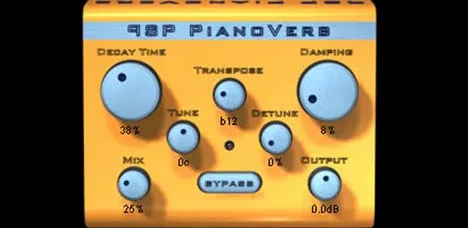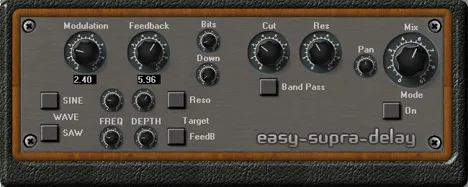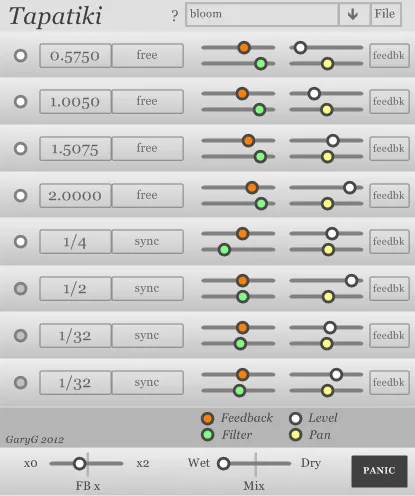PSP PianoVerb: Piano String Reverberation
In the world of effect plugins, where emulations of classic spaces or digital algorithms dominate, there are occasionally tools that offer a truly unique approach. PSP PianoVerb is one such case. This plugin does not try to imitate a concert hall or a spring reverb in the usual sense. Instead, it reproduces a special, organic type of reverberation that arises from the vibration of the strings of an acoustic piano.
Imagine how sound spreads inside a grand piano, causing other strings to resonate, creating a complex, lively and deep response. It is this unique acoustic behavior that the developers of PSP AudioWare sought to recreate in their PianoVerb plugin. This is not just an “echo”, but rather a multi-layered, harmonically rich resonance that can add incredible depth and character to your tracks.
Unique Concept and Implementation
The heart of PianoVerb is a system of twelve “string operators”. Each of these operators functions as a separate resonating string, excited by the incoming audio signal. An important feature is that each of these twelve operators is fixed to a specific note within one octave – from A (A, with a frequency of about 55 Hz) to G sharp (G#, with a frequency of about 103.8 Hz). This range covers the lower part of the piano register, which is responsible for the most resonant and deep sound of the instrument.
This approach differs from traditional reverbs that use delays, filters, or physical space emulations. PianoVerb creates reverberation through sympathetic vibration, similar to how piano strings resonate in response to sounds that were not directly played on the keyboard. This gives the effect a musical character, as the resonances are related to specific harmonic frequencies.
Key Features and Parameters
PianoVerb provides the user with several important parameters to shape the sound:
- Damping: Allows you to control the rate of decay of the string operators’ vibrations, affecting the brightness and duration of the reverb tail. Higher values “damp” the sound faster, making it drier, while lower values allow the resonance to last longer.
- Decay Time: Adjusts the overall duration of the reverberation effect. This parameter works in conjunction with damping, allowing you to precisely adjust how long the “string echo” will be present in the mix.
- Transpose: One of the most creative features of the plugin. The entire system of twelve string operators can be transposed within ±24 semitones (two octaves) from the initial setting. This parameter dramatically changes the character of the reverb, as described below.
- Tune: Allows you to precisely “tune” the pitch of the entire system of string operators within ±100 cents (one semitone). This is useful for accurately matching the plugin’s resonances to the key of your track or for creating a slightly detuned “vintage” effect.
- Detune: Adds a small, independent detuning to each of the twelve string operators. This can make the reverb more dense, rich, and “chorus-like”, simulating a slight inaccuracy in the tuning of real piano strings or creating a lush “shimmer” effect.
Sound Palette and Creative Applications
The ability to transpose the string operator system is key to understanding the sonic possibilities of PianoVerb. Changing the register in which the virtual strings resonate has a radical effect on the character of the reverb:
- Transposition to lower octaves: When the system is set to lower frequencies, the reverb becomes more voluminous, deep and less resonant in the high frequency range. This sound may resemble traditional spring reverbs or create a feeling of a large, but not too “bright” space. This is a great choice for creating a sense of foundation and “body” of sound.
- Transposition to higher octaves: Raising the resonance register creates a completely different effect. The reverb takes on a bright, shimmering, almost “harp-like” or “metallophone” character. High-frequency overtones become dominant, adding air, shine and fragility. This mode is ideal for creating ethereal atmospheres, adding “shimmer” to pads or vocals, or obtaining unique percussive textures.
Thanks to this flexibility, PianoVerb is used not only for processing piano parts. It can add unique texture to guitars (both acoustic and electric), synthesizers, vocals, strings and even drums (to create specific, resonant percussive effects). Experiments with the Damping, Decay, Tune, and Detune parameters allow you to obtain a wide range of sounds – from delicate resonances to dense, otherworldly soundscapes.
Technical Details
PSP PianoVerb is available as a VST plugin, making it compatible with most modern digital audio workstations (DAWs) on Windows (Win32) and macOS (OSX) operating systems. This ensures easy integration into your existing workflow.
Conclusion
PSP PianoVerb is not just another reverb effect in your collection. It is an instrument with its own character and unique timbre that opens up new horizons for sound design and creative mixing. Its ability to reproduce the resonances of piano strings, combined with flexible settings and transposition capabilities, makes it a valuable asset for any musician, producer or sound engineer who is looking for something special that will set their music apart.
If you’re tired of standard reverbs and want to add an organic, lively and musically integrated space to your compositions, PSP PianoVerb certainly deserves your attention.



